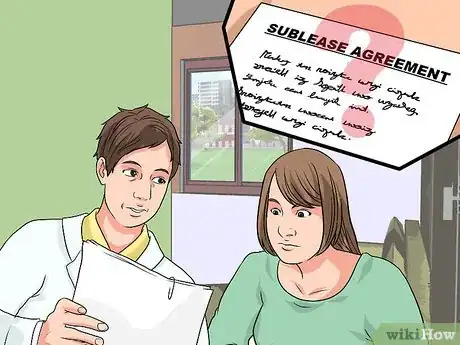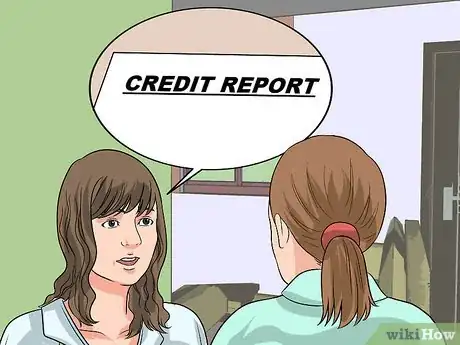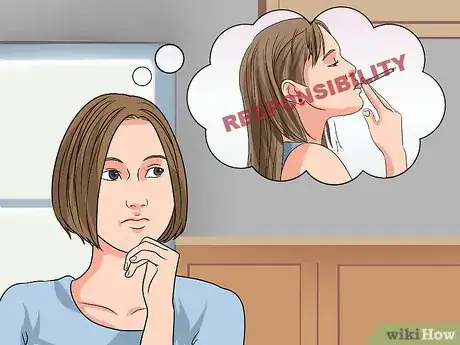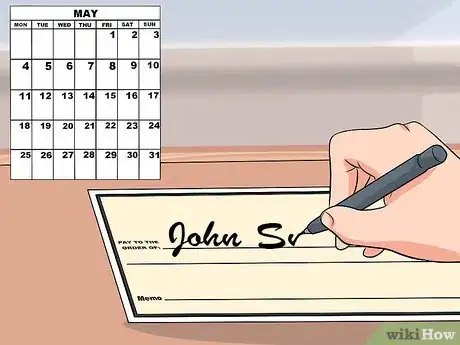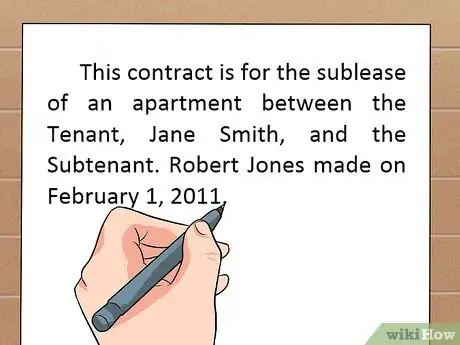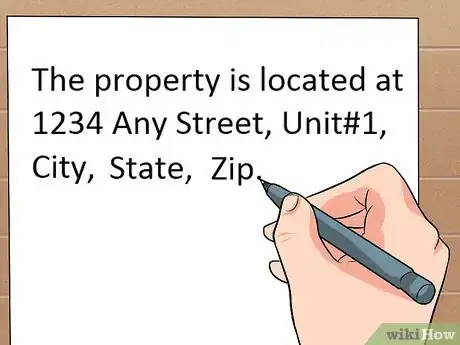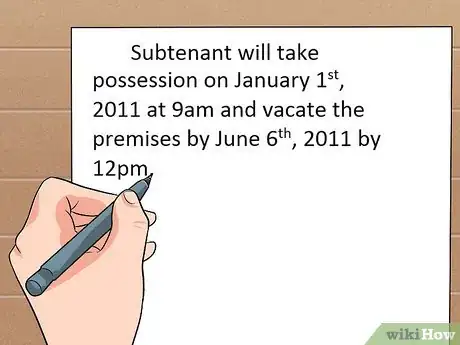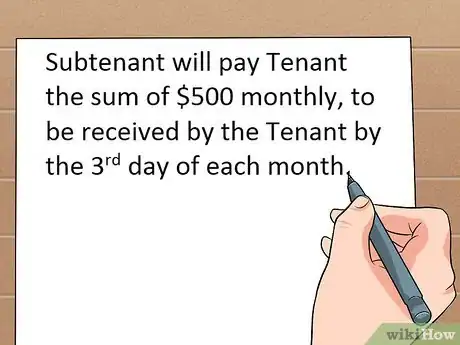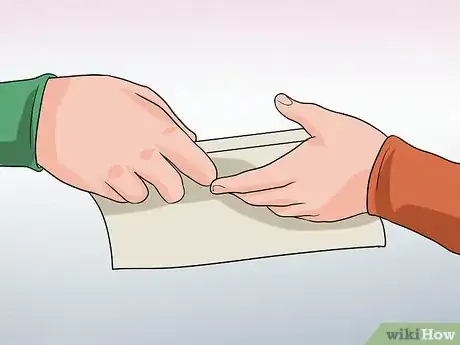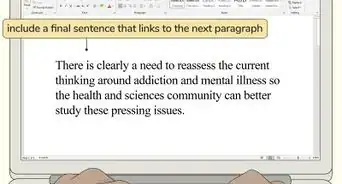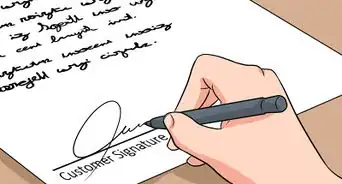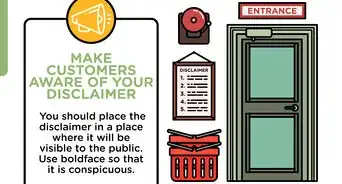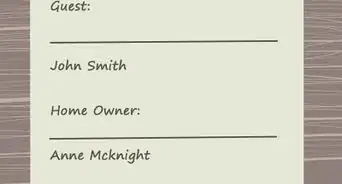This article was co-authored by Clinton M. Sandvick, JD, PhD. Clinton M. Sandvick worked as a civil litigator in California for over 7 years. He received his JD from the University of Wisconsin-Madison in 1998 and his PhD in American History from the University of Oregon in 2013.
There are 13 references cited in this article, which can be found at the bottom of the page.
This article has been viewed 494,645 times.
When the tenant of a particular piece of property wishes to give his or her rights under the lease to another party, the situation warrants a sublease. Subleases can apply to both residential and commercial property. Depending on what the original lease of the property states, the landlord of the property may need to give permission to the tenant to sublet the premises. To protect both the current tenant and the subtenant, it is important to have a contract in place that describes each party’s rights and responsibilities. Commercial tenants should speak with an attorney to draft a sublease agreement due to the high value of the property. A residential tenant can draft a sublease for all involved parties to agree to and sign.
Steps
Sample Sublease
Planning to Sublease
-
1Determine if you are allowed to sublease. In most cases, you will need to check with your landlord to make sure that you have permission to sublease your dwelling. Your landlord will almost always have to approve the subtenant, just as you went through an approval process when you leased the place. Your landlord has the right to refuse to allow a sublease. Always get your landlord’s written permission to sublease.[1]
- Subletting is intended to be a temporary arrangement. For example, if you live in one city to attend college but go back home to a different city over the summer, you could potentially sublease your college-town dwelling for the summer months.[2]
- If your arrangement is not temporary -- e.g., you are moving out early and do not plan to return -- that is called an assignment. Assigning a lease is a different procedure that permanently transfers all responsibility from you to the new tenant.[3]
- Do not sublease your dwelling without obtaining your landlord’s permission. You could be subject to legal actions and/or eviction for violating the terms of your lease.[4] For example, in Texas, if you do not obtain consent before subleasing, your landlord can evict your subtenant. Your landlord can also sue both you and your subtenant.
-
2Collect and provide information on your subtenant’s reliability. Your landlord will be more likely to consider your subtenant if you can show that s/he is a reliable, responsible person. Even if the subtenant is a friend, ask for a credit report and references from previous landlords, where possible.[5]
- You can talk with your landlord if you are not certain about what questions to ask.
Advertisement -
3Remember that you remain responsible for the leased dwelling. As the original tenant, you are responsible for abiding by all of the terms of your lease. You are also responsible for any violations that may occur from your subtenant.[6]
- For example, if you have a clause in your lease that says you will forfeit your security deposit if you smoke in your apartment, your subtenant must also abide by that. If your subtenant smokes in the apartment, you will be liable for the damages.
- In most states, you become your subtenant’s landlord even though you are still responsible to your own landlord for the property. For example, if the property needs a repair, your tenant must request this repair from you. You will then request the repair from your landlord.
-
4Consider how you will handle security deposits. If it is legal in your state, you should get a deposit from your subtenant.[7] In the event that damages happen to the property, you will be held liable. A security deposit will help protect you.[8] [9] Many states impose strict regulations on security deposits, such as requiring the landlord to hold the security deposit in a separate account or pay interest on it.[10]
- Be aware that many states have restrictions on how much a security deposit can be and who can collect one. For example, in Massachusetts, it is illegal for a landlord to collect a security deposit that is more than the amount of one month’s rent. Thus, if your rent is $800 and you have already paid an $800 security deposit, your landlord could not legally collect a security deposit from your subtenant under Massachusetts law.[11]
- It’s also advisable to provide a move-in statement on the property’s condition before your subtenant moves in. Several states require one, but even if it is not required, a statement will protect you and the subtenant. You should note specifics about the condition of your dwelling, such as scratches on woodwork, spots on carpet, etc. Have both you and the subtenant sign this statement.[12]
-
5Determine how rent will be paid. Before signing your sublease, you and the subtenant should work out who will give the rent money to the landlord each month. You can each send checks for your portion, or the subtenant can pay his/her share of the rent to you.
- You should also determine how much of the rent your subtenant will be liable for. In some states, you cannot charge your subtenant more for rent than you pay.[13] In many cases, you can expect to recover between 70-80% of your rent from a sublease, unless you are subleasing it furnished. Furnished sublets tend to command a higher rate.[14]
- If your subtenant is paying only a portion of your rent, you could prepay the entire portion of the rent that your sublease does not cover. This protects your subtenant in the event that you are unable or unwilling to continue paying your share. However, you could lose the prepaid money if your subtenant violates the lease agreement.
- Be aware that when you and your subtenant sign the sublease, you are both required to abide by its terms. If your subtenant is only paying a portion of your rent each month -- which is a very common situation -- you must continue paying the difference so that your landlord receives the rent in full. If you or the subtenant do not pay, you will be in violation of the lease. If you do not pay, your subtenant and your landlord may sue you.
Writing Your Sublease
-
1State the name of the parties and the date of the contract. Identify the full names of each party and what their role is in the contract. The original leaseholder of the property is the Tenant and the person subletting the property is the Subtenant.
- For example, “This contract is for the sublease of an apartment between the Tenant, Jane Smith, and the Subtenant, Robert Jones made on February 1, 2011.”
-
2Identify the property. State the full address of the property. For example, “The property is located at 1234 Any Street, Unit #1, City, State, Zip.”
- If the sublease is for something other than the full use of the property—only the use of a garage, for example—state this in the description of the property.
- If the property is for residential purposes, as in the case of a house or an apartment, state that the subleased premises are to be used for residential purposes only. A commercial lease should state that the property is to be used for commercial use only.
-
3Provide the term of the sublease. State the date the sublease begins and the date the sublease ends. Determine in advance the time at which the subtenant will take and surrender possession.
- For example, “Subtenant will take possession on January 1st, 2011 at 9 AM and vacate the premises by June 6th, 2011 by 12 PM.”
-
4State the rent schedule and amount. State the agreed upon rental amount and when the subtenant must pay it. In the sublease of property, the subtenant usually pays monthly. For example, “Subtenant will pay Tenant the sum of $500 monthly, to be received by the Tenant by the 3rd day of each month.”
- Include any penalty for late payment in this section as well. For example, “If rent is not received by the 3rd day of the month, a $50 late fee will be added to the amount of rent due.”
- Include the payment recipient by name. Include the address to which the subtenant must send the rent as well.
- You should also make it clear what your own financial contributions will be. For example, if your rent is $1000 and your subtenant will pay $850, you must pay $150 per month. Alternately, you can include a clause that specifies that you have paid your share in full (e.g., $450 for three months) and the subtenant is responsible for the remaining portion.
-
5Include a section on the security deposit. If the subtenant must pay a security deposit, state the amount of the deposit and information about the return of the security deposit at the expiration of the lease.
- The contract should state that if the Tenant withholds the security deposit or any portion of the security deposit, the Tenant will provide the Subtenant with a written statement of the reason. The tenant should provide this statement and any returned portion of the deposit within two weeks of the subtenant vacating.
- Describe possible reasons for withholding the security deposit in the contract. Typical reasons include nonpayment of rent, outstanding late payment fees, and damage (beyond normal wear and tear) to the premises.
- Walk through the rental space with the subtenant and fill out a move-in/move-out checklist. Document the condition of the rental space both at the move-in and move-out date. This helps determine what, if any, damages the subtenant caused during the sublease period.
-
6Sign and date the contract. Both parties should sign the contract using their full legal names. Each party should retain a copy of the contract.
-
7Deliver the contract to your landlord. Make multiple copies of the signed sublease agreement: one for you, one for your subtenant, and one for your landlord. It is highly recommended that you send the sublease agreement and a letter containing your information (e.g., how to contact you) via certified mail with a return receipt. This will be your proof that your landlord has received the sublease.[15]
Warnings
- If in doubt, have your contract checked by a legal professional. You may have to pay for the document review. However, it will cost less than having a lawyer draft the document in the first place.⧼thumbs_response⧽
- Be careful to whom you sublet your space. In most cases, you will remain liable for rent. That means if your subletter stops paying rent, you will have to pay the entire rent and attempt to recover it from your subtenant.⧼thumbs_response⧽
- Though providing certain legal information, this article should not be taken as legal advice.⧼thumbs_response⧽
- If your lease does not mention subleasing, ask your landlord in advance for permission. Otherwise, illegal subletting can put you in danger of eviction by your landlord.[16]⧼thumbs_response⧽
- If you need additional guidance, contact a legal professional or your local tenant rights organization. For a detailed list of resources regarding tenant rights, visit: http://portal.hud.gov/hudportal/HUD?src=/topics/rental_assistance/tenantrights⧼thumbs_response⧽
References
- ↑ http://money.usnews.com/money/blogs/my-money/2014/06/25/everything-you-need-to-know-about-subletting
- ↑ http://www.masslegalhelp.org/housing/private-housing/ch12/subletting-your-apartment
- ↑ http://www.masslegalhelp.org/housing/private-housing/ch12/assigning-your-lease
- ↑ http://www.masslegalhelp.org/housing/private-housing/ch12/subletting-your-apartment
- ↑ http://money.usnews.com/money/blogs/my-money/2014/06/25/everything-you-need-to-know-about-subletting
- ↑ http://www.masslegalhelp.org/housing/private-housing/ch12/subletting-your-apartment
- ↑ http://www.forbes.com/sites/trulia/2014/07/18/how-to-sublet-your-apartment/
- ↑ http://www.nolo.com/legal-encyclopedia/security-deposit-limits-deadlines-your-state-36186.html
- ↑ http://money.usnews.com/money/blogs/my-money/2014/06/25/everything-you-need-to-know-about-subletting
- ↑ http://www.nolo.com/legal-encyclopedia/free-books/renters-rights-book/chapter4-2.html
- ↑ http://www.masslegalhelp.org/housing/private-housing/ch12/subletting-your-apartment
- ↑ http://www.nolo.com/legal-encyclopedia/protect-security-deposit-move-in-30231.html
- ↑ http://money.usnews.com/money/blogs/my-money/2014/06/25/everything-you-need-to-know-about-subletting
- ↑ http://www.forbes.com/sites/trulia/2014/07/18/how-to-sublet-your-apartment
- ↑ http://realtytimes.com/consumeradvice/rentaladvice1/item/19261-20001102_sublett2
- ↑ http://www.sfgate.com/realestate/rentwatch/article/Rent-Watch-Illegal-subletting-could-lead-to-4547326.php
About This Article
To write a sublease contract, begin by noting the names of the parties to the agreement and the date. For example, write, “This contract is for the sub-lease of an apartment between the tenant, Robert Smith, and sub-tenant, James Jones, made on September 2, 2018.” Follow this by stating the property’s full address. Next, include the start and end dates for the lease, followed by how much rent will be paid. You may also want to include details of a security deposit if you’re asking for one. Finish your contract by dating it and having both parties sign it. Afterwards, make multiple copies of the agreement and give 1 to your landlord, 1 to the sub-tenant, and keep 1 for yourself. For tips from our Legal co-author on how to decide whether sub-letting is a good idea, keep reading!

